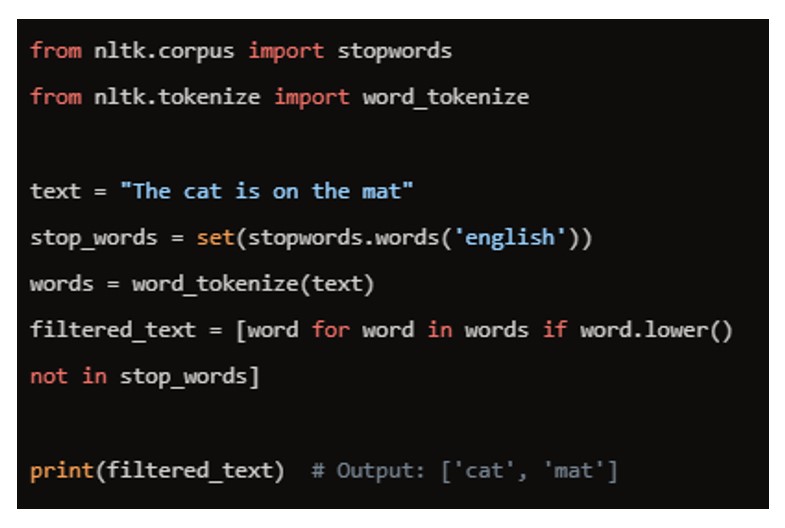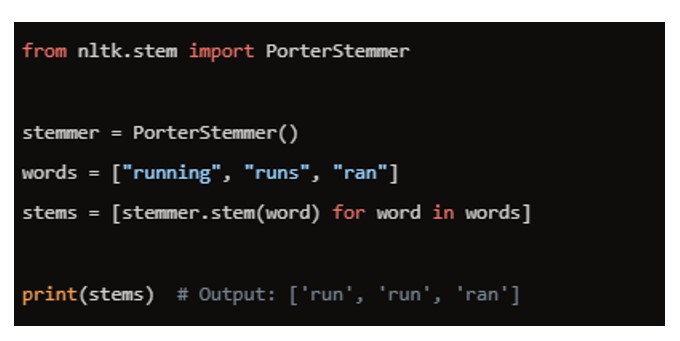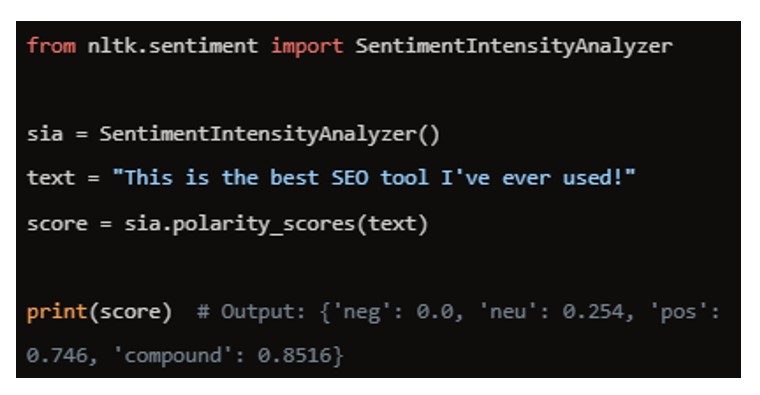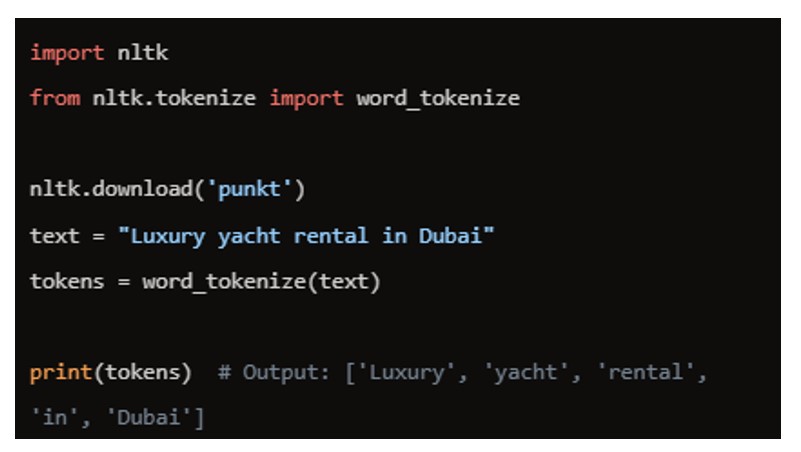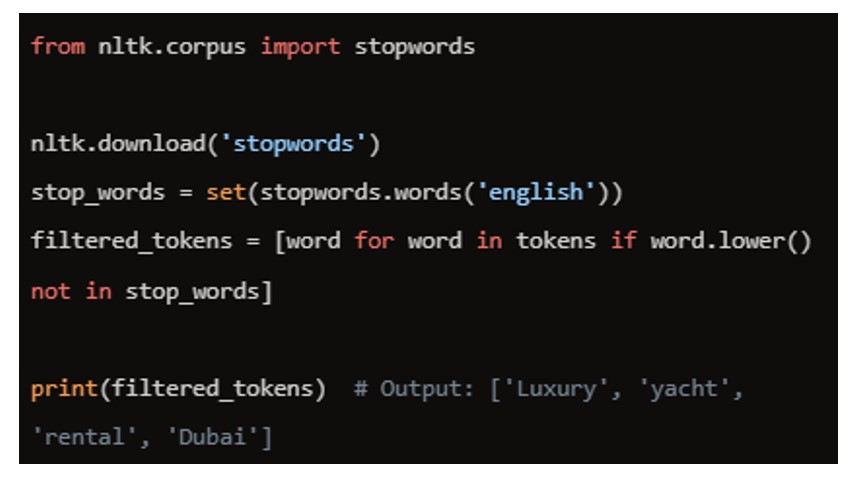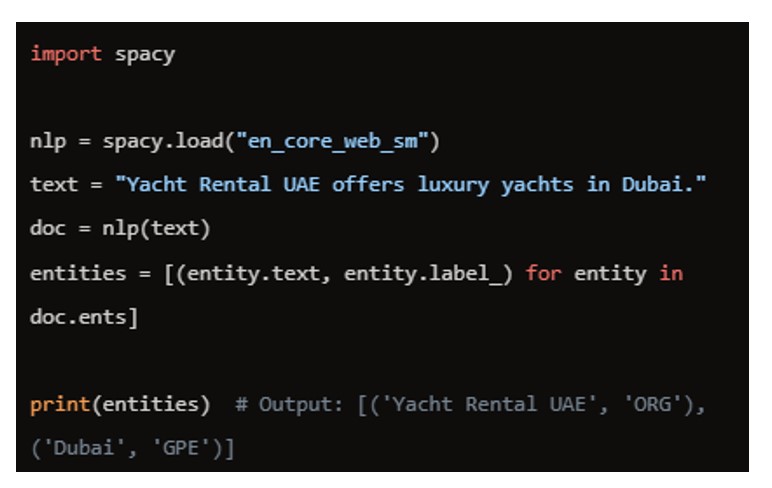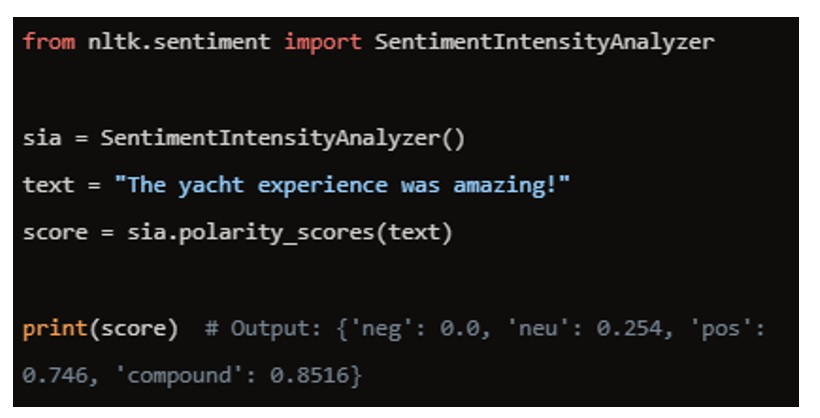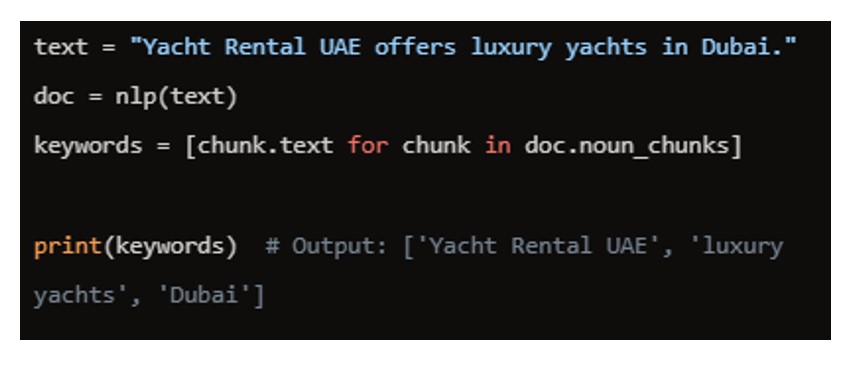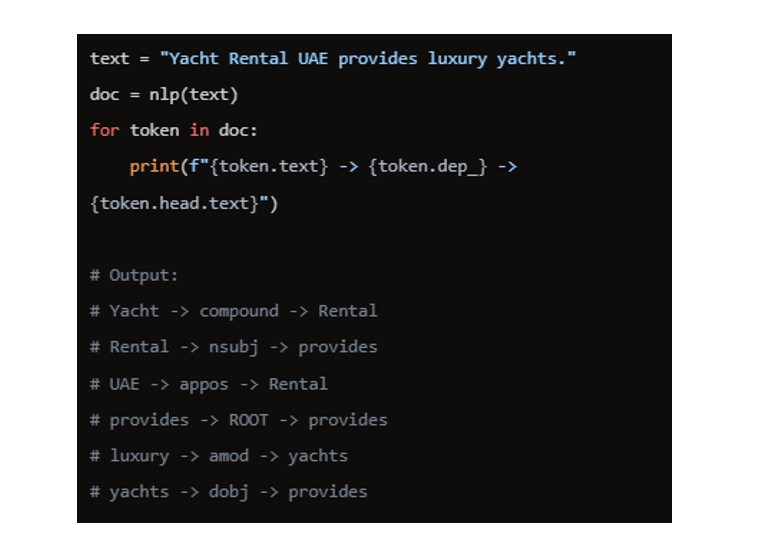What are Common NLP Tasks in SEO?
- Tokenization
- Stop Word Removal
- Stemming and Lemmatization
- Named Entity Recognition (NER)
- Sentiment Analysis
- Keyword Extraction
- Semantic Analysis
- Dependency Parsing
Tokenization
Tokenization breaks text into smaller units called tokens. These tokens can be words, phrases, or characters. For example, the sentence “Natural Language Processing is fun” in a tokenized form is: [“Natural”, “Language”, “Processing”, “is”, “fun”]. Tokenization has several benefits:
- Tokenization breaks text into manageable units for improved keyword extraction and content analysis.
- It identifies and focuses on important words/terms and improves content alignment with user queries.
- It simplifies tasks like text processing, making it easier to handle large volumes of content.
- Tokenization simplifies the understanding behind search queries in terms of context and meaning.
Stop Word Removal
Stop word removal filters out common words like “is,” “the,” and “in” from the content because these don’t add significant meaning to the text. For example, removing stop words from the sentence “the cat is on the mat” will give us “cat mat.”
So, this is important for semantic SEO as it focuses on words that make sense and are meaningful. The purpose is to improve content relevance and search engines’ efficiency. That way, search engines understand the content better and index the core text quickly. Here is how we used the NLTK library for removing stop words:
Stemming and Lemmatization
Stemming decreases words to their root form. It processes words and removes suffixes. Next, Lemmatization converts words to their base form using a dictionary. Both are very important for SEO and NLP as they normalize text, improving keyword matching and search relevance.
In addition, they reduce dimensionality, enhancing text analysis and machine learning accuracy. In Python, use NLTK for stemming and spaCy for Lemmatization. The following figure shows the code we have written in Python to achieve our goal of stemming and Lemmatization.
Named Entity Recognition (NER)
NER identifies, classifies, and analyzes entities in text into predefined categories. These include names, organizations, dates, and locations. Consider this sentence: “Steve Jobs founded Apple Inc. in Cupertino in 1976.” NER identifies “Steve Jobs” as a person, “Apple Inc” as an organization, “Cupertino” as a location, and “1976” as a date.
Sentiment Analysis
Sentiment Analysis in NLP identifies the emotional tone of the text, classifying it as positive, negative, or neutral. It helps understand user sentiment towards content, improving relevance and engagement in Semantic SEO. Python allows this with libraries like NLTK and TextBlob. The following code analyzes the sentiment of the text. It provides a score that helps us optimize content for SEO and better user experience.
Keyword Extraction
Keyword extraction identifies important words or phrases from the text to enhance content relevance and search engine optimization. In healthcare, consider a sentence like “The patient was diagnosed with diabetes and prescribed metformin.”
Here, the key terms are “patient,” “diabetes,” and “metformin.” These words are essential for understanding the medical context and improving the content’s relevance to health-related searches.
Let me give you another example. In sports betting, take the sentence, “The odds for the upcoming soccer match favor England over France.” The key terms are “odds,” “soccer match,” “England,” and “France.”
Semantic Analysis
Semantic analysis in NLP interprets the meaning of text by examining relationships between words and context. Let’s take the example of digital marketing to understand this concept.
So, in digital marketing, it helps understand customer feedback and sentiment. For example, analyzing reviews like “The new campaign is innovative and engaging” identifies positive sentiment and key terms like “innovative” and “engaging.” Thus, this insight helps marketers refine strategies and create content that resonates with their audience.
Dependency Parsing
Dependency parsing in NLP analyzes grammatical relationships between words in a sentence, creating a tree structure that shows how words depend on each other. It helps understand sentence structure and meaning. It improves content relevance by identifying key relationships and enhancing keyword targeting in Semantic SEO.
Python helps with dependency parsing using libraries like spaCy. For example, spaCy can parse a sentence to identify subjects, objects, and modifiers, aiding in content optimization and better search engine understanding.
NLTK Vs. SpaCy Vs. TextBlob for NLP and Semantic SEO
| Feature | NLTK | spaCy | TextBlob |
| Ease of Use | Moderate | Easy | Very Easy |
| Speed | Slower | Fast | Moderate |
| Pre-trained Models | Limited | Extensive | Limited |
| Language Support | Multiple | Multiple | English |
| Customization | High | Moderate | Low |
| Documentation | Comprehensive | Excellent | Good |
| Community Support | Large | Growing | Moderate |
| Best For | Research | Production | Simple Tasks |
NLTK, spaCy, and TextBlob are used for NLP and Semantic SEO by processing and analyzing text data. NLTK offers tools for Tokenization, stemming, and Lemmatization, aiding in keyword extraction and content analysis.
spaCy provides fast, efficient processing for tasks like named entity recognition and dependency parsing, enhancing content relevance. TextBlob simplifies sentiment analysis and part-of-speech tagging, which is helpful for understanding user intent and optimizing content.
Case Study: NLP and Semantic SEO for Yacht Rental UAE
Objective
At Never Stop Media, our objective was to improve the content management and SEO performance for a company called Yacht Rental UAE website using NLP techniques to improve Google rankings, content relevance, and user engagement.
Step 1: Tokenization
We used Tokenization in Python to break down text into individual words or phrases. For example, the sentence “Luxury yacht rental in Dubai” becomes [“Luxury”, “yacht”, “rental”, “in”, “Dubai”]. Here is the code our developers “Abed” and “Gugan” wrote:
Step 2: Removing the Stop Word
We then remove the stop words from the tokenized list. So, from [“Luxury”, “yacht”, “rental”, “in”, “Dubai”], removing stop words leaves [“Luxury”, “yacht”, “rental”, “Dubai”].
Step 3: Stemming and Lemmatization
The next step was stemming and Lemmatization. Our developers discussed the process with me, and I provided them with insights regarding SEO to streamline this step. For instance, we made the words “renting” and “rented” become “rent.” The following figure shows the Python code for stemming and Lemmatization for Yacht Rental UAE.
Step 4: Named Entity Recognition (NER)
In “Yacht Rental UAE offers luxury yachts in Dubai,” “Yacht Rental UAE” is an organization and “Dubai” is a location.
Step 5: Sentiment Analysis
“The yacht experience was amazing!” is classified as positive.
Step 6: Keyword Extraction
From “Yacht Rental UAE offers luxury yachts in Dubai,” extract “Yacht Rental UAE,” “luxury yachts,” and “Dubai.”
Step 7: Semantic Analysis
Analyzing “Yacht Rental UAE offers luxury yachts in Dubai” helps understand the context and relevance of the content. Our team integrated semantic analysis with other NLP tasks, such as NER and sentiment analysis, to streamline the process and pave the path for dependency parsing.
Step 8: Dependency Parsing
In “Yacht Rental UAE provides luxury yachts,” “Yacht Rental UAE” is the subject, and “provides luxury yachts” is the predicate.
Step 9: Content Optimization
Our team integrated the extracted keywords and optimized the content into Yacht Rental UAE’s website. We rewrote the existing content to naturally include keywords like “luxury yachts,” “Dubai,” and “yacht rental.” In addition, we updated meta titles, descriptions, and headers with these keywords to improve Google visibility.
Step 10: Monitoring
We used Ahrefs to monitor and evaluate the SEO performance of Yacht Rental UAE. We tracked keyword rankings, analyzed backlinks, and identified content gaps. We adjusted our strategies based on the insights provided by Ahrefs, focusing on high-impact keywords and improving content quality. The following figure shows the results of growing traffic from 1.5k to 3.9k:
Final Words: Improve Your Digital Presence with NSM
We hope you understand how to use Python for NLP and Semantic SEO. Never Stop Media (NSM) follows unique strategies for digital marketing and SEO to ensure our clients achieve exceptional results. Contact NSM today and improve your digital marketing and online presence on Google and other search engines.

